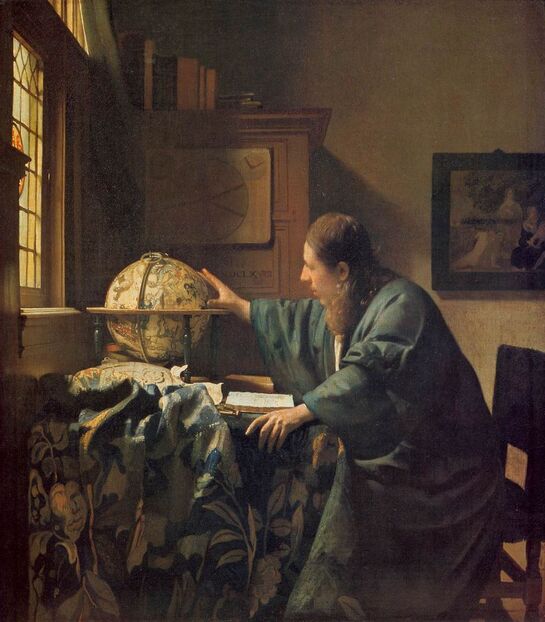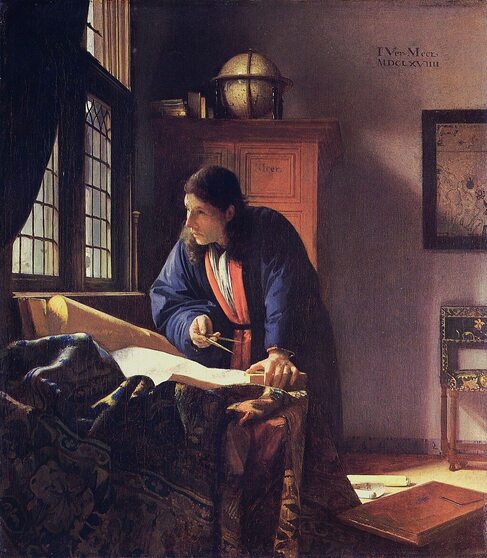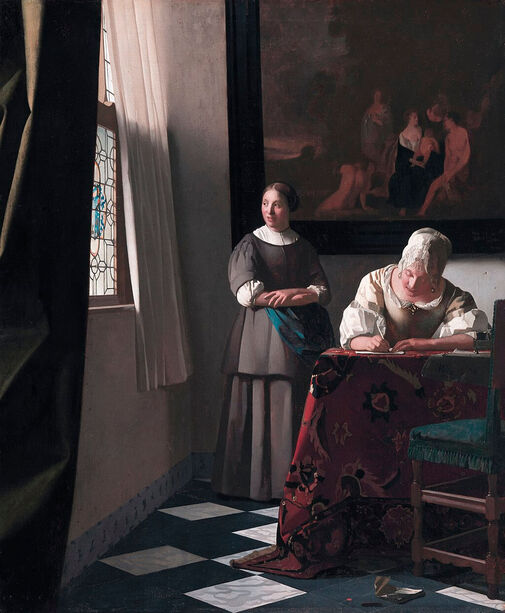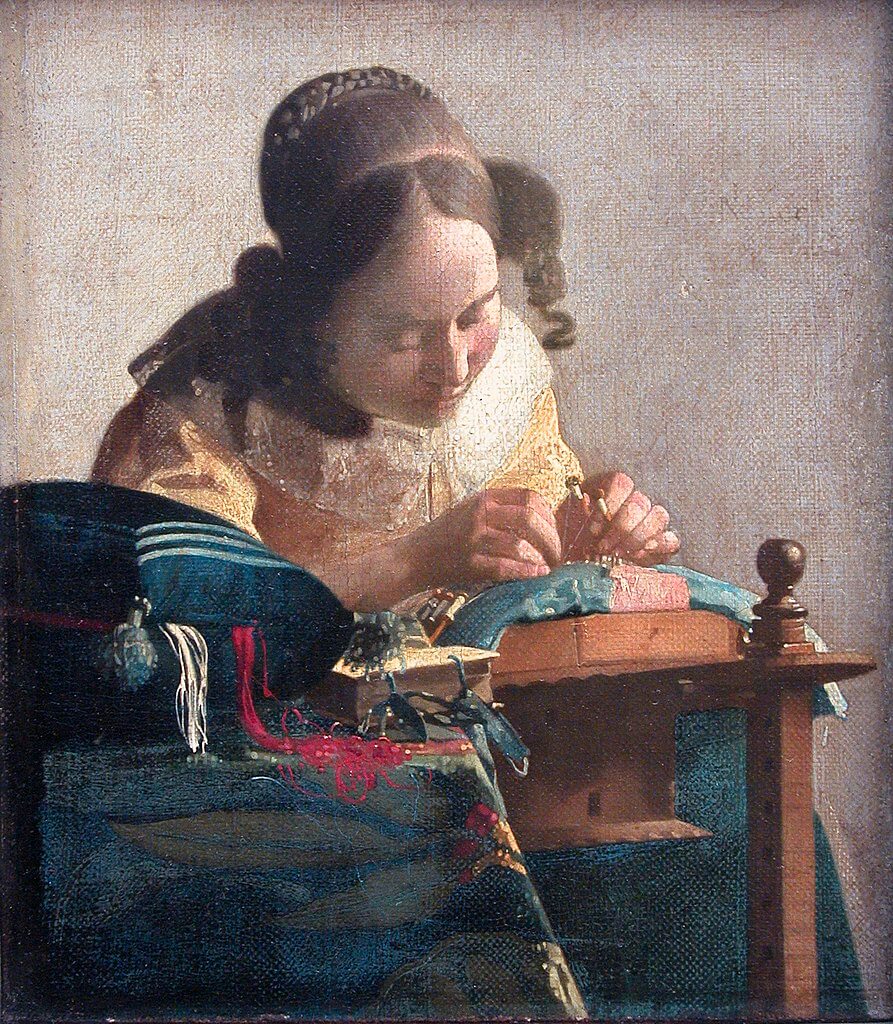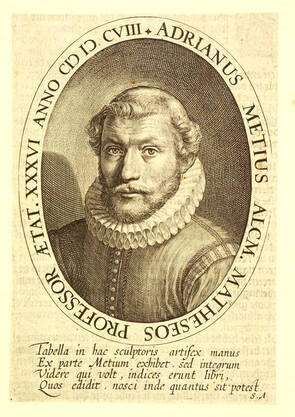|
Where? Second floor, room 837 of the Richelieu wing in the Louvre
When? 1668 What do you see? A seated man with long hair inspects an astronomical globe in front of him. Next to the globe lays an astrolabe, an instrument to make astronomical measurements. In front of the astronomer is an open book on astronomy on the table. The book is opened on a section on the stars. There are also some other books on the table, as well as a divider tool. The table is covered with a blue-green, thick tapestry with yellow flower decorations. The astronomer wears a voluminous blue cloak and gently touches the globe with his right hand. He is in the middle of his activities and Vermeer captures a frozen moment in time. It seems that he is making a discovery. The astronomer is the same person as the man in Vermeer’s The Geographer, which he painted one year later. In the background is a large closet with books on top of it. In front of the closet hangs a drawing of a chart with radial lines on it (a celestial planisphere). Below this chart is the inscription of Vermeer’s name and the date of the painting. On the right side of the wall hangs a painting on The Finding of Moses, which may be another painting by Vermeer that has gone missing. The Finding of Moses is also used in the background of Vermeer’s Lady Writing a Letter with Her Maid in the National Gallery of Ireland.
Light: The light is coming through the window on the left and Vermeer masterfully incorporates this light into the painting. The light illuminates the globe, the face and hands of the astronomer, and part of the tapestry of the table.
Backstory: This painting was sold several times together with The Geographer by Vermeer. The two paintings were probably companion pieces given the many similarities between the two (the same man, tapestry, and closet, as well as the similarity in the size and fabric of the paintings). The two professions often went together. A geographer was often also an astronomer at that time, as geography was related to the positioning of the stars. Globe makers at that time usually made both a celestial and a terrestrial globe. The terrestrial globe can be seen in Vermeer’s The Geographer. The Astronomer was considered the better of the two paintings. For example, in 1797, The Geographer was sold for an equivalent of $53 and The Astronomer for $108, both at the same auction. The painting has been in the Louvre since 1983. Who is Vermeer? Johannes Vermeer (1632-1675) was a perfectionist in his paintings and did not quickly produce his works to earn money. However, because of this, and the eleven surviving children that he had, he died as a poor man suffering from depression. He often took multiple months to finish a painting and regularly completely repainted big parts of a painting. He is known for his brilliant use of light in his works and may have been inspired by Caravaggio for that. Vermeer had a preference for females in his paintings, and this is only one of two paintings in which a solitary man was depicted (the other one being The Geographer in the Städel Museum in Frankfurt). No known image of Vermeer has ever been painted. He is mainly remembered for his genre pieces, which include The Lacemaker in the Louvre and The Milkmaid in the Rijksmuseum in Amsterdam.
Written by Eelco Kappe
References:
2 Comments
Karen
4/26/2021 01:02:26 am
you should add the history of the astronomer, that it was owned by the rothschilds which was stolen by the Nazis. and I assume later given to the Louvre by The Rothchilds?
Reply
Eelco Kappe
4/26/2021 01:51:54 pm
Thanks, that is indeed a very interesting aspect of the history of this painting, and I have added a couple of lines referring to this at the bottom of the post.
Reply
Leave a Reply. |
Categories
All
|
- Home
- Blog
-
Museums
- Alte Pinakothek
- Art Institute of Chicago
- Baltimore Museum of Art
- Barber Institute of Fine Arts
- Bargello
- Barnes Foundation
- British Museum
- Church of Sant’Anastasia
- Cleveland Museum of Art
- Courtauld Institute of Art
- Detroit Institute of Arts
- Frans Hals Museum
- Galleria Borghese
- Gallerie dell'Accademia
- Getty Museum
- Guggenheim
- Hermitage Museum
- Kunsthistorisches Museum
- Kunstmuseum Basel
- Legion of Honor Museum
- Louvre
- Mauritshuis
- Metropolitan Museum of Art
- Musee d’Orsay
- Museum of Fine Arts in Boston
- Museum of Modern Art
- National Gallery in London
- National Gallery of Art
- National Museum in Poznań
- Norton Simon Museum
- Ny Carlsberg Glyptotek
- Palace of Versailles
- Palazzo Pitti
- Palazzo Vecchio
- Petit Palais
- Philadelphia Museum of Art
- Prado
- Pushkin Museum
- Ravenna Art Museum
- Rijksmuseum
- San Diego Museum of Art
- Santa Maria delle Grazie
- St. Peter's Basilica
- Städel Museum
- Statens Museum for Kunst
- Tate Britain
- Tate Modern
- Timken Museum of Art
- Uffizi
- Vatican Museums
- Wallace Collection
-
Artists
- Altdorfer
- Anguissola
- Berlin Painter
- Bosch
- Botticelli
- Boucher
- Bronzino
- Bruegel the Elder
- Brunelleschi
- Cabanel
- Caillebotte
- Canova
- Caravaggio
- Carpeaux
- Cezanne
- Cimabue
- David
- Degas
- Delacroix
- De Maria
- Donatello
- El Greco
- Fontana
- Fra Angelico
- Fragonard
- Gauguin
- Gentileschi
- Gericault
- Gonzalez-Torres
- Goya
- Hals
- Hogarth
- Hokusai
- Ingres
- Leonardo da Vinci
- Lippi, Filippo
- Longhi, Barbara
- Lorrain
- Makovsky
- Manet
- Massys
- Matisse
- Merian
- Michelangelo
- Mochi
- Modigliani
- Monet
- Panini
- Parmigianino
- Perugino
- Picasso
- Pisanello
- Raphael
- Rembrandt
- Renoir
- Reynolds
- Rivera
- Rodin
- Rubens
- Scultori
- Seurat
- Steen
- Tintoretto
- Titian
- Toulouse-Lautrec
- Turner
- Uccello
- Van der Weyden
- Van Dyck
- Van Eyck
- Van Gogh
- Van Hemessen
- Vasari
- Velazquez
- Vermeer
- Veronese
- Vigée Le Brun
-
Locations
- Books
- About Us

